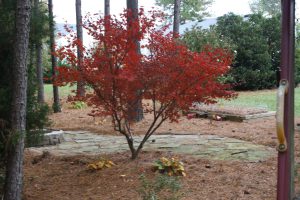
Intense red fall color of Japanese Maple in Georgia is hard to replicate in our climate. J_McConnell, UF/IFAS
Fall is a favorite time of year for many people. Cool nights, short days, football games and the fast approaching holidays are all signs of summer coming to an end. Floridians who have relocated from other parts of the country may be disappointed to realize we get very little showy fall color even though we can grow some of the same trees in North Florida as other parts of the country. Why is that? Well, although plant breeders may promise “showy fall color” in certain selections, they really can’t promise that year after year because it’s more than just genetics influencing leaf color. Let’s take a deeper dive into the science behind fall color!
Why do the leaves change color?
Lower temperatures and shorter day length indicate to plants that winter is approaching and some physiological changes start to occur. Chlorophyll is a pigment found in leaves that, in addition to capturing sunlight and producing energy, also causes plants to display green during the growing season. As fall approaches, environmental changes tell plants to stop producing chlorophyll and existing pigment begins to break down. The reduction of chlorophyll allows the other pigments present (carotenoids and anthocyanin) to reveal their colors in an array of yellows, browns, oranges, reds, and purples. Different plants have different levels of these pigments and some may not exist at all in certain species. This explains why some plants typically turn only yellow and others may show yellow, orange, and/or red!
Why is there so much difference from year to year?
Variation occurs because environmental conditions and cultural practices play a part in determining how much color will be on display. Rainfall or irrigation amounts in the preceding summer and fall, drought cycles, nutrient levels, sunlight, and day and night temperatures all influence color from year to year.
How do I increase the potential for showy fall color in my landscape?
Choose plants with the reputation of producing desired fall colors in our area. However, keep in mind that because of the influence of outside conditions, you may be in for a surprise from year to year. To increase your chance of having a somewhat predictable fall display, use cultivars instead of seedlings of a plant species. A cultivar is a selection of a plant species that has been chosen for desirable traits, like growth habit, flowering, or fall color. These attributes are usually easily identified by the way their names are assigned. For example, Acer rubrum ‘October Glory’ is a red maple cultivar known for a full rounded canopy and exceptional red fall color. The reason that cultivars appear more consistent is because they are genetic copies of the parent plant that they are named for. A species or seedling plant is not a clone but comes from seed, which means you will get as much genetic variation as you see in human siblings. Just like children in our own families, each will each shine in their own way and no two will be exactly alike.
- Break the Breeding Cycle to Minimize Mosquitoes - June 26, 2025
- What’s the buzz about bee flies? - May 15, 2025
- What Vegetables Can I Plant in April? - April 3, 2025
